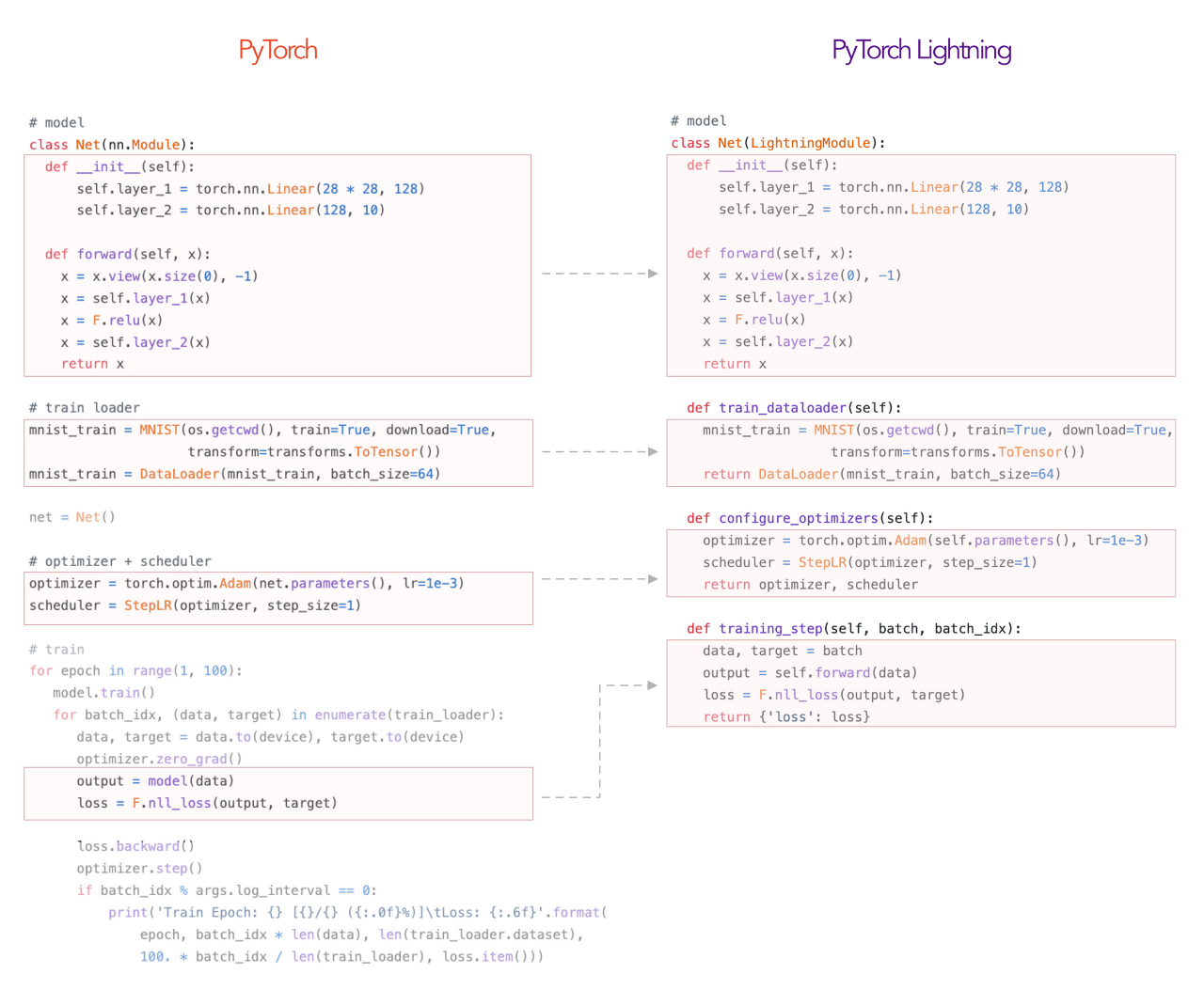PyTorch : PyTorch 프로젝트 구조 이해하기
Introduction
- 많이들 Jupyter notebook을 통해 ML/DL 입문을 하고 코드를 접한다.
- 하지만 Jupyter notebook에는 한계가 존재한다.
- 배포 및 공유의 어려움 $\rightarrow$ 재현의 어려움과 실행순서의 꼬임
- 이를 해결하고자 Deep Learning 코드를 하나이 프로그램으로 작성할 필요가 있다.
- 개발의 용이성 확보, 유지보수 향상
- 앞서 Python의 OOP 개념을 배운 것이 여기써 쓰인다.
PyTorch Template
- 파이토치의 템플릿의 종류는 다양한데 그 중 일부를 소개하겠다.
- 사용자의 필요에 따라 수정하여 사용한다.
- train, data_loader, model, config, logging, metric, utils 등 다양한 모듈로 분리하여 프로젝트를 사용한다.
- 실제로 많은 기업들과 대학원 연구실에서 템플릿을 활용하는 방식을 사용한다.
PyTorch Template Project
1
2
3
4
5
6
7
8
9
10
11
12
13
14
15
16
17
18
19
20
21
22
23
24
25
26
27
28
29
30
31
32
33
34
35
36
37
38
39
40
pytorch-template/
│
├── train.py - main script to start training
├── test.py - evaluation of trained model
│
├── config.json - holds configuration for training
├── parse_config.py - class to handle config file and cli options
│
├── new_project.py - initialize new project with template files
│
├── base/ - abstract base classes
│ ├── base_data_loader.py
│ ├── base_model.py
│ └── base_trainer.py
│
├── data_loader/ - anything about data loading goes here
│ └── data_loaders.py
│
├── data/ - default directory for storing input data
│
├── model/ - models, losses, and metrics
│ ├── model.py
│ ├── metric.py
│ └── loss.py
│
├── saved/
│ ├── models/ - trained models are saved here
│ └── log/ - default logdir for tensorboard and logging output
│
├── trainer/ - trainers
│ └── trainer.py
│
├── logger/ - module for tensorboard visualization and logging
│ ├── visualization.py
│ ├── logger.py
│ └── logger_config.json
│
└── utils/ - small utility functions
├── util.py
└── ...
- PyTorch Template Project는 아마도 많이 사용하는 형태의 템플릿이 아닐까 싶다.
train.py,test.py- train 및 test가 실제로 실행되는 코드이다.
- 템플릿의 핵심이 되는 코드들 중 하나이다.
config.json,parse_config.pyconfig.json은 모델의 학습 또는 데이터 관련 등 ML 프로젝트의 설정을 담고 있는 파일이다.parse_config.py는ConfigParser라는 클래스가 작성되어있다.1 2 3 4 5 6 7 8 9 10 11 12 13 14 15 16 17 18 19 20 21 22 23 24 25 26 27 28 29
@classmethod def from_args(cls, args, options=''): """ Initialize this class from some cli arguments. Used in train, test. """ for opt in options: args.add_argument(*opt.flags, default=None, type=opt.type) if not isinstance(args, tuple): args = args.parse_args() if args.device is not None: os.environ["CUDA_VISIBLE_DEVICES"] = args.device if args.resume is not None: resume = Path(args.resume) cfg_fname = resume.parent / 'config.json' else: msg_no_cfg = "Configuration file need to be specified. Add '-c config.json', for example." assert args.config is not None, msg_no_cfg resume = None cfg_fname = Path(args.config) config = read_json(cfg_fname) if args.config and resume: # update new config for fine-tuning config.update(read_json(args.config)) # parse custom cli options into dictionary modification = {opt.target : getattr(args, _get_opt_name(opt.flags)) for opt in options} return cls(config, resume, modification)
핵심적인 코드 중 하나인데 입력으로 들어온 argument들을 파싱하여 ConfigParser 객체로 반환하는 역할을 한다.
여기에 같이 구현된 mangling 함수 중__getitme__이 있는데1 2 3
def __getitem__(self, name): """Access items like ordinary dict.""" return self.config[name]
이 함수는
ConfigParser객체에 한해서[]로 딕셔너리 접근을 가능하게 만들어주는 역할을 한다.
data_loader/,data/- 이 폴더에는
data_loader.py와 학습을 위한 데이터가 들어있다. data_loader는 모델 학습에서 중요하게 쓰이는데 이 부분의 구현이 된 부분이다.
- 이 폴더에는
model/- 이 폴더는 우리가 학습에 사용할 모델의 구조가 구현된 부분이다. 물론 모델만 있는 것은 아니지만 대부분
model.py에 새로운 모델을 클래스로 구현해서train.py나test.py에 적용하여 모델을 생성한다.
- 이 폴더는 우리가 학습에 사용할 모델의 구조가 구현된 부분이다. 물론 모델만 있는 것은 아니지만 대부분
trainer/- 가장 핵심이 되는 파일이다.
model.py에 존재하는 모델을 사용해서 학습을 본격적으로 진행하는 코드이다.train.py에 있는main함수에 다음과 같은 코드가 있다.1 2 3 4 5 6 7 8 9 10
def main(config): ... trainer = Trainer(model, criterion, metrics, optimizer, config=config, device=device, data_loader=data_loader, valid_data_loader=valid_data_loader, lr_scheduler=lr_scheduler) trainer.train()
여기서 trainer가
trainer.py에 구현된 Trainer클래스의 객체를 사용한다.
utils/- 프로젝트에 사용되는 다양한 짜잘짜잘한 함수들을 구현한 파일이 있다.
PyTorch Lightning

- PyTorch Lightning은 간단하게 말하면 TensorFlow의 Keras 같은 존재이다.
- PyTorch의
nn.Module을 상속해서 모델을 생성하는 방식을 많이 사용하지만 Multi-GPU나 TPU, 분산학습 등 복잡한 실험환경에서는 코드가 길어지는 경우가 발생한다.
이를 해결하고자 좀 더 간결하고 집중하고자 하는 곳에 더 집중할 수 있게 도움을 주는 것이 PyTorch Lightning의 역할이다.

- 아마
sci-kit learn에서 model을 만들고model.fit으로 한방에 학습을 시켜본 기억이 있을 것이다.
PyTorch Lightning은 이렇게 코드 자체를 획기적으로 줄여주는 역할을 한다.
1
2
3
4
5
6
7
8
9
10
11
12
13
14
15
16
17
18
19
20
21
22
23
24
25
26
27
28
29
# ----------------
# TRAINING LOOP
# ----------------
num_epochs = 1
for epoch in range(num_epochs):
# TRAINING LOOP
for train_batch in mnist_train:
x, y = train_batch
logits = pytorch_model(x)
loss = cross_entropy_loss(logits, y)
print('train loss: ', loss.item())
loss.backward()
optimizer.step()
optimizer.zero_grad()
# VALIDATION LOOP
with torch.no_grad():
val_loss = []
for val_batch in mnist_val:
x, y = val_batch
logits = pytorch_model(x)
val_loss.append(cross_entropy_loss(logits, y).item())
val_loss = torch.mean(torch.tensor(val_loss))
print('val_loss: ', val_loss.item())
이랬던 코드를
1
2
3
4
5
# train
model = LightningMNISTClassifier()
trainer = pl.Trainer()
trainer.fit(model)
이렇게 만들 수 있다.
PyTorch Lightning 써보기
Model 구현
1
2
3
4
5
6
7
8
9
10
11
12
13
14
15
16
17
18
19
20
21
22
23
24
25
26
27
28
class Classifier(pl.LightningModule):
def __init__(self):
super().__init__()
self.model = nn.Sequential(
nn.Flatten(),
nn.Linear(28 * 28, 64),
nn.BatchNorm1d(64),
nn.ReLU(inplace=True),
nn.Linear(64, 64),
nn.BatchNorm1d(64),
nn.ReLU(inplace=True),
nn.Linear(64, 10)
)
def forward(self, x):
pass
def training_step(self, batch, batch_idx):
pass
def validation_step(self, batch, batch_idx):
pass
def test_step(self, batch, batch_idx):
pass
def configure_optimizers(self):
pass
- PyTorch Lightning을 활용한 모델은 위와 같은 구성으로 구현하면된다.
training_step과configure_optimizers는 반드시 구현해야한다.def __init__(self)- 이 부분은 모델 그래프를 구현하는 곳이다.
def forward()1 2
def forward(self, x): return self.model(x)
모델의 추론 결과를 제공할 때 사용한다.
nn.Module처럼 반드시 정의하는 부분은 아니지만 다른 메서드 구현때 편리하므로 구현하는 것이 좋다.def training_step()1 2 3 4 5
def training_step(self, batch, batch_idx): x, y = batch logits = self(x) loss = F.cross_entropy(logits, y) return loss
training_step은 학습 루프의 body이다. 이 메소드에는 argumetn에 train dataloader가 제동하는 batch와 batch index가 주어지고 이를 활용해 학습 loss를 계산한다.
PyTorch Lightning은 CPU, GPU 세팅을 따로 설정하지 않아도 trainer 설정에 맞춰 자동으로 typecasting을 해준다.configure_optimizers1 2 3
def configure_optimizers(self): optimizer = Adam(self.parameters()) return optimizer
configure_optimizers는 모델의 최적 파라미터를 찾을 때 사용할 optimizer와 scheduler를 구현한다.
학습모델이 여러개면 리스트로 리턴을 해주면된다. 여기서는 모델이 1개이므로 Adam만 사용했다.- 학습 및 테스트
1
2
3
4
5
6
7
8
9
10
11
12
13
14
15
16
17
18
pl.seed_everything(args.seed) # 재생산을 위한 랜덤시드 고정
# dataloaders
dataset = MNIST('', train=True, download=True, transform=transforms.ToTensor())
train_dataset, val_dataset = random_split(dataset, [55000, 5000])
test_dataset = MNIST('', train=False, download=True, transform=transforms.ToTensor())
train_loader = DataLoader(train_dataset, batch_size=args.batch_size)
val_loader = DataLoader(val_dataset, batch_size=args.batch_size)
test_loader = DataLoader(test_dataset, batch_size=args.batch_size)
# model
model = Classifier()
# training
trainer = pl.Trainer(max_epochs=args.n_epochs, gpus=args.n_gpus)
trainer.fit(model, train_loader, val_loader)
trainer.test(test_dataloaders=test_loader)
- Keras에서 MNIST를 학습하고 테스트할 때와 유사한 코드를 보여주고 있다.
- 위에서 모델을 구현해두면 간단하게 모델을 학습, 테스트 할 수 있는 것을 볼 수 있다.

Comments powered by Disqus.